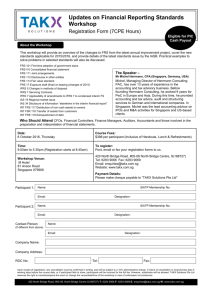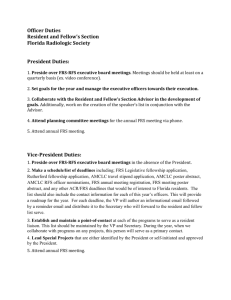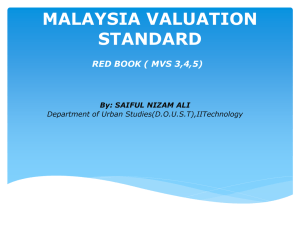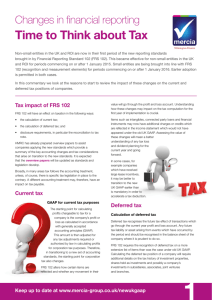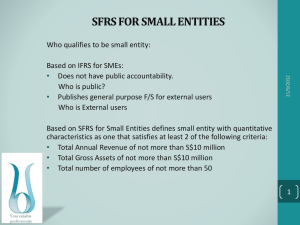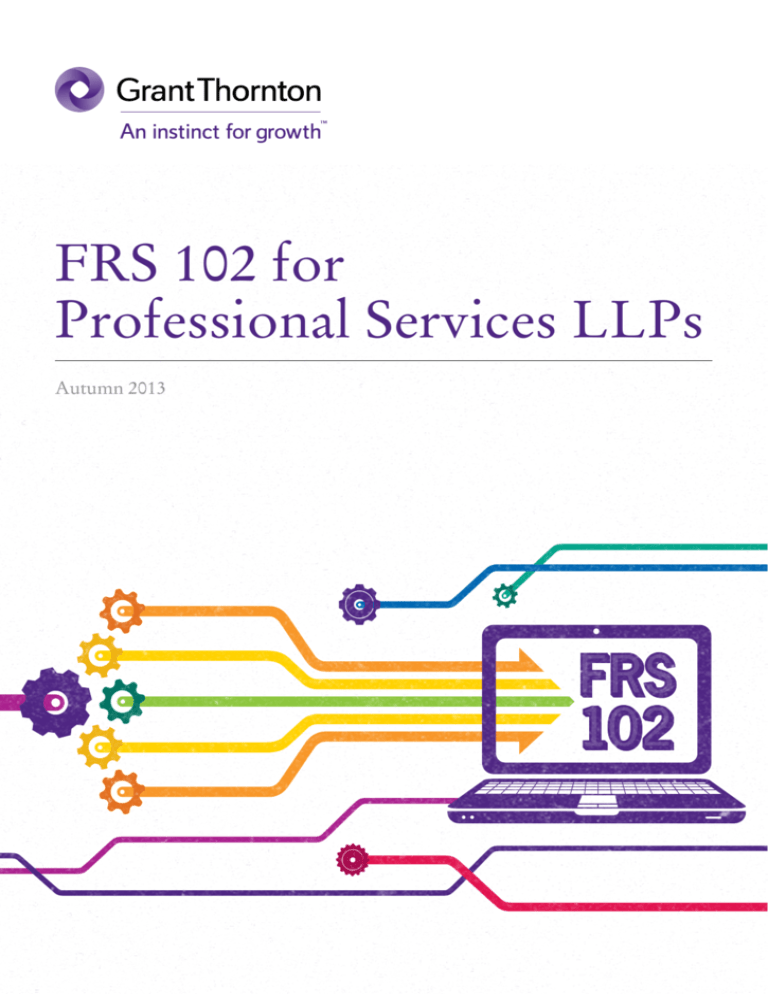
FRS 102 for
Professional Services LLPs
Autumn 2013
Key issue
Acquisitions and mergers
Useful life of intangible assets and goodwill
Classification of leases and treatment of lease incentives
Defined benefit pension schemes
Multi-employer defined benefit pension schemes
Significant issue
Short term compensated absence (holiday pay)
Foreign currency translation
Financial statement presentation
Intra-group loans
Requiring consideration
Cash flow statement
Revenue
Related party disclosures:
key management personnel compensation
Investments in subsidiaries
Key dates:
Year end
First year end for
FRS 102 financial
statements
Transition date
(the opening balance sheet
of the comparative period)
31 December
31 December 2015
1 January 2014
31 March
31 March 2016
1 April 2014
30 April
30 April 2016
1 May 2014
Other date
year end in 2016
year end plus one day in 2014
FRS 102 and UK GAAP – the key differences
In the long term, FRS 102 will have a number of advantages
over current UK GAAP. UK GAAP has become
increasingly complicated and cumbersome over the years,
and with different standards applying depending on whether
a company is private, a plc, listed on an EU-regulated market
or listed on any market, it can be confusing too. Inevitably,
the transition period will cause disruption but in the longer
term financial reporting will be more robust and more
straightforward.
• FRS 102 is planned to be more stable, with amendments
made through an omnibus exposure draft every three years
• It will be less complicated to determine which
requirements apply to a particular business and was
written with the needs of privately held businesses in
mind, with one set of rules for all entities adopting it
• FRS 102 is a UK-adapted version of the IFRS for SMEs,
which is one small, self-contained standard. It was
deliberately written to be easier to read and more accessible
than full IFRS
• It will be more comparable internationally, which is a
particular advantage for groups with overseas subsidiaries
Area of difference
UK GAAP
FRS 102
Acquisitions and ‘mergers’
• Acquisition accounting, or
merger accounting where the
conditions are met
• Use purchase method (essentially
acquisition accounting) for
nearly all combinations. Merger
accounting permitted for group
reorganisations but no concept of
true merger
• Goodwill can arise
• The excess of consideration over
fair value of assets and liabilities
needs to be broken down into its
constituent intangibles. It is no
longer simply ‘goodwill’ but needs
to be set out as a list of intangibles
acquired (eg future profits on
contracts, brand etc)
Useful life of intangible assets
and goodwill
• Option to have an indefinite
useful life, with annual
impairment reviews
• No indefinite useful life permitted
for intangible assets and goodwill –
if a useful life cannot be estimated
reliably, five years is used, but any
period that can be demonstrated to
be valid is acceptable
Classification of leases and
treatment of lease incentives
• Based on transfer of
substantially all of risks and
rewards of ownership. If
present value of minimum lease
payments is 90% or more of the
fair value, normally classify as
finance lease.
• Based on transfer of substantially
all of the risks and rewards of
ownership. Assessment made
against qualitative criteria
• Lease incentive released over
period to first market rent review
• Lease incentives are released over
the lease term
Area of difference
UK GAAP
FRS 102
Defined benefit pension
schemes
• Valued based on the projected
unit credit method, with a full
actuarial valuation every three
years
• Defined benefit liability will be
on individual balance sheet(s).
Simplifications permitted. No need
for independent actuary, albeit that
for all but the simplest scheme,
actuarial input is likely to be
required
Multi-employer defined benefit
pension schemes
• Treat as defined contribution
where it is not possible to identify
own share of assets and liabilities
• Treat as defined contribution
if sufficient information is not
available to use defined benefit
accounting
• Recognise a liability for any funding
agreement
• Group schemes - at least one entity
in the group must recognise the
liability
Short term compensated
absence (holiday pay)
• No accrual is made for any
unused holiday entitlement at
the year end
• An accrual is required for the value
of the unused holiday entitlement
carried over at a financial year end
Foreign currency translation
• Option to use forward contract
rate where criteria are met*
• No use of forward contract rate
(recognise foreign exchange
forward contracts as financial
instruments). Option to translate
into a different presentation
currency
• Accounts are presented in local
currency
*only where FRS 26 is not applied
Financial statement
presentation
• Current presentation requires a
balance sheet, a profit and loss
account, a statement of total
recognised gains and losses, a
cash flow statement and notes,
including accounting policies
• The LLP SORP prescribes the
formats and headings required
• FRS 102 requires the presentation
of a statement of financial
position, either a statement of comprehensive income or an
income statement and statement
of comprehensive income, a
statement of changes in equity, a
statement of cash flows and notes,
including accounting policies
• Presentation format continues to
be determined by the existing LLP
SORP
Area of difference
UK GAAP
FRS 102
Intra-group loans
• Creditor recognised at the
amount payable. Debtor
recognised at the amount
receivable less any impairment
• Both debtor and creditor measured
at fair value initially – ie estimating
the cash flows and discounting at a
market rate
• For some groups, the impact could
be significant
Cash flow statement
• Exemption for 90% subsidiaries
and small companies
• Exemption for qualifying subsidiary
and for qualifying parent company
individual accounts
• Format changes (new headings)
Revenue
• FRS 5 Application Note G
principles similar to IAS 18
• Looks from point of view of
asset/liability recognition
Related party disclosures:
key management personnel
compensation
• Requirement to disclosure
transactions and balances
between related parties, where
they are material to either party.
• Derived from IAS 18. Mostly similar
to UK GAAP as UITF 40 and IAS
18 were drafted at the same time.
We are not aware of any significant
differences for professional service
firms in relation to the majority of
revenue types but do not take it for
granted they will be the same for
all circumstances
• Similar requirement to disclose
transactions and balances between
related parties, where they are
material to either party
• Additional requirement to disclose
the aggregate compensation
(remuneration plus benefits) paid
or payable to ‘key management
personnel’
Investments in subsidiaries
• Cost or valuation, movements
go to STRGL
• Cost or fair value. Movements go
to other comprehensive income or
profit or loss
Other commercial considerations
On the previous pages, we have
highlighted some of the areas you will
need to consider during any impact
assessment.
For an LLP, our view is that the
impact on the figures presented is only
part of the overall picture, with the
following further matters arising:
Does my members’ agreement set
out how I will deal with the financial
impact of transition to FRS 102?
We recommend that you review your
members’ agreement to assess whether
it has clauses within it that allow you to
vary the amount of profit you allocate to
your members so as to be able to adjust
for any such differences arising. Whilst
this may seem an academic issue, should
you have members joining or leaving
the LLP at the time, it is likely to lead to
concerns around what is equitable and
if you don’t have a legally clear position
within your members’ agreement you
will have an unhelpful exposure.
When transitioning to FRS 102, most
will find themselves with issues that
lead to restatements of balances and
an impact on the cumulative members’
interests position. This gives rise to the
need to consider how these restatements
interact with your historic and future
profit sharing arrangements, and
requires you to review your members’
agreement to see whether it has clauses
within it that set out what to do in such
instances. We have yet to see a members’
agreement that includes clauses that
set out the approach to be adopted
for differences arising on a change of
underlying accounting framework so our
feeling is that most will need to revise
their agreements.
Any of the adjustments arising from
the transition could give rise to a similar
issue – ie finishing the UK GAAP era
Let’s use an example to bring this to life:
For a 30 April year end, the first set of full financial statements to be
prepared under FRS 102 will be 30 April 2016.
This means that the 30 April 2015 financial statements will be the last ones
prepared under UK GAAP (as modified by the LLP SORP).
FRS 102 transition provisions mean that if you are part way through a lease
incentive period, provided the term of the lease commenced before the date of
transition to this FRS, you can elect to continue to recognise any residual benefit
or cost associated with these lease incentives on the same basis as that applied at
the date of transition to this FRS.
But if you enter into a lease incentive after your transition date (see earlier table),
there is an issue to be addressed:
• At 30 April 2015, the firm is one year into a new 10 year lease.
• They received a lease incentive of £2 million and this is being spread over a five
year period to the first full rent review.
If the members’ agreement requires profits to be allocated based on the profit
reported in the profit and loss account under UK GAAP, then the collective of
members within the business have received 1/5th of the lease incentive at that
time (they will have shared in the benefit of £0.4 million of the incentive). Under
FRS 102, such a lease incentive would be required to be spread over the full
period of the lease, rather than the period to the first rent review.
Although a prior year adjustment would be used to deal with the accounting
aspects of this, that wouldn’t change the fact that £0.4 million of the incentive has
been allocated to members by this point. Therefore, as at 30 April 2015 (the prior
year position when the first set of FRS 102 financial statements are prepared) the
firm would be reporting its figures on the basis that it had only taken 1/10th of the
incentive to the profit and loss as a credit. This equates to only £0.2 million.
Within the balance sheet it would have deferred income of a further £1.8 million
to be released to profit, and therefore allocated to members in future years. So
as at 30 April 2015, it had allocated £0.4 million of the incentive, but under FRS
102 it would still have a further £1.8 million to allocate in future years. Unless
the profits to be allocated under the members’ agreement are able to be altered,
this would theoretically lead to £2.2 million of the £2 million lease incentive being
allocated over the period of the lease. Clearly that isn’t something that would be
commercially viable and needs careful consideration to avoid disputes on arrival or
departure of members around this time.
If you consider also a need for a holiday pay accrual in the 2015 comparatives,
the ‘over allocation of cumulative profits’ issue becomes greater – see the
illustration below:
Year
2015
Capital account
£1,000,000
Curent account
£650,000
£nil
Holiday pay accrual
(£250,000)
Lease incentive adjustment
(£200,000)
Revised comparative current account
Members’ interests
Allocated
FRS 102 transition
adjustment
2015
revised comparative
£1,000,000
£200,000
£1,650,000
£1,200,000
£650,000
Allocated £450,000 more than
cumulative members’ interests
on 30 April 2015 with one figure for the cumulative members’
interests figure, and yet opening up on day one of the new FRS
102 era with a restated brought forward cumulative members’
interests figure. This needs careful consideration to avoid
disputes on arrival or departure of members around this time.
Managing expectations – who should I consider?
You will have two audience classes – the internal and
external ones.
Bank and
other
lenders
Do I continue to use the LLP SORP as a guide to
presentation and disclosure?
The initial plans to withdraw the LLP SORP (and other
SORPs) have been reversed with the position being that the
SORP should be used alongside FRS 102 in the same way
that it currently is alongside UK GAAP. The SORP should
therefore be used in conjunction with FRS 102 rather than
on a stand-alone basis. In the event of conflict, FRS 102 takes
precedence over the SORP but where the SORP adds further
requirements or details specific treatments or disclosures,
these will apply.
The requirement to disclose the aggregate remuneration
of key management personnel
Working on those LLPs who have adopted IFRS has
highlighted a very practical issue with the requirement now
adopted within FRS 102 under related parties disclosure to
disclose the aggregate remuneration of ‘key management
personnel’ and that is, how do you define ‘key management
personnel’? From an entirely objective external viewpoint, we
would describe ‘key management personnel’ as being those
members who make up the ‘Board’ or equivalent.
However, the very ‘personal’ nature of the members’
involvement with their LLP has meant that we have seen
situations where discussion about who should or shouldn’t be
included within this disclosed aggregate figure has become
quite an emotive subject. The standard did not set out to cause
disharmony amongst the member ranks by asking firms to
clarify who is or isn’t considered ‘key’, and certainly wouldn’t
expect any credible disclosure to include all members (in the
same way a corporate wouldn’t consider all its shareholders to
be ‘key’ simply because they hold shares) but do be prepared
for this to cause a degree of internal debate around whether
heads of practice groups, or high performing individuals are
‘key’ or not.
Suppliers
Members
and
employees
Regulator
Press
Internal - your members and employees: ensure that you
have done an impact assessment for consideration by the
management team, and then start to set out the key messages
to the members at an early stage so they aren’t left suddenly
wondering ‘why the numbers changed’.
External: these interested parties will have varying levels
of understanding of FRS 102 and therefore their ability to
understand the figures presented to them will be significantly
dependent upon the quality of the disclosure and narrative
contained within the initial set of FRS 102 financial statements
as part of the transition disclosures. These require you to:
• disclose changes in accounting policies
• provide a reconciliation of ‘equity’ (read members’ interests
for an LLP) at the transition date and the period end date
of the last set of financial statements prepared under UK
GAAP, showing the differences between the UK GAAP
and FRS 102 positions
• provide a reconciliation between the profit and loss
presented in the last set of financial statements prepared
under UK GAAP and the FRS 102 profit and loss for that
same period.
We will be working with the banks and regulators to
highlight the impact of the transition to FRS 102 but we
encourage you to prepare thorough presentations to these
external audiences when providing them with your first set of
FRS 102 financial statements.
How can Grant Thornton assist?
We have significant experience of assisting clients with transitions from one
accounting framework to another, and with much of FRS 102 being derived
from existing IFRS, much knowledge of the areas of impact.
If we are your existing auditors:
We can provide you with guidance, review and support as you prepare your
impact assessment, but need to ensure that, for audit independence reasons set
by statute, we do not ‘prepare your FRS 102 adjustments’.
If we are not your existing auditor:
We can perform all services, up to and including a full outsourcing by you of
the impact assessment and preparation of the revised figures under FRS 102.
Please do contact us if you wish to receive support
or discuss the above further.
© 2013 Grant Thornton UK LLP. All rights reserved.
Grant Thornton UK LLP is a member firm of Grant Thornton
International Ltd (GTIL). GTIL and the member firms are
not a worldwide partnership. Services are delivered by the
member firms. GTIL and its member firms are not agents
of, and do not obligate, one another and are not liable for
one another’s acts or omissions.
Please see grant-thornton.co.uk for further details.
V23358

